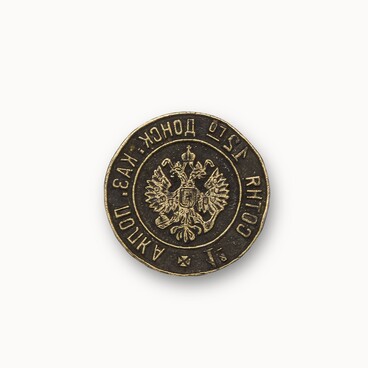A chalice is a cup used for the Christian rite of the Eucharist, or the Holy Communion. In Russian, a chalice is known as a “potir”, from the Greek word for “cup”. The first chalices were made of wood. Some cups were also jeweled and made of precious metals such as gold and silver. In the 3rd century, glass chalices appeared, similar to the one from the museum’s collection. Made of a fragile material, the cup is painted yellow on the inside and has a round foot. The outer surface features a grapevine pattern painted white.
The sacramental wine poured into the cup during the Eucharist changes into the blood of Jesus Christ which is served to the communicants. The shape of the chalice changed throughout its history. In the past, it could also be made in the form of a jug. The early Christians partook of the bread and wine eaten and drunk separately.
In Byzantine, chalices were often made in the shape of an inverted tapered cone. Some cups had two handles to the sides. This type was particularly popular in the pre-Mongolian Rus. In fact, the first chalices were regular goblets. Of course, they were used exclusively for sacraments.
The chalice is usually stored beside other sacred vessels on the credence or in a special vault. Usually, each Christian church has several chalices: during major religious holidays when there are many priests and communicants, the largest chalice is used from which the blood of Christ is poured into the other cups.
Many chalices can be regarded as works of decorative and applied arts of superb craftsmanship. The dome-shaped cups were carved out of stone, such as pure quartz, jasper, onyx, and others, and set in precious metals. According to church traditions, a chalice could not be made of copper or its alloys which were prone to corrosion.
Since the times of old, Orthodoxy was the spiritual foundation of the Cossack community, and the Cossacks were faithful protectors of the Orthodox Church. Christianity formed the basis of their lifestyle and traditions, where serving God, the Tsar, and the Motherland was the meaning of life.
The sacramental wine poured into the cup during the Eucharist changes into the blood of Jesus Christ which is served to the communicants. The shape of the chalice changed throughout its history. In the past, it could also be made in the form of a jug. The early Christians partook of the bread and wine eaten and drunk separately.
In Byzantine, chalices were often made in the shape of an inverted tapered cone. Some cups had two handles to the sides. This type was particularly popular in the pre-Mongolian Rus. In fact, the first chalices were regular goblets. Of course, they were used exclusively for sacraments.
The chalice is usually stored beside other sacred vessels on the credence or in a special vault. Usually, each Christian church has several chalices: during major religious holidays when there are many priests and communicants, the largest chalice is used from which the blood of Christ is poured into the other cups.
Many chalices can be regarded as works of decorative and applied arts of superb craftsmanship. The dome-shaped cups were carved out of stone, such as pure quartz, jasper, onyx, and others, and set in precious metals. According to church traditions, a chalice could not be made of copper or its alloys which were prone to corrosion.
Since the times of old, Orthodoxy was the spiritual foundation of the Cossack community, and the Cossacks were faithful protectors of the Orthodox Church. Christianity formed the basis of their lifestyle and traditions, where serving God, the Tsar, and the Motherland was the meaning of life.




